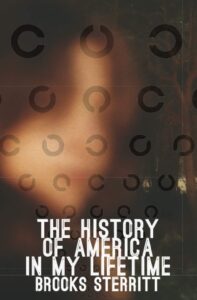
[Spuyten Duyvil; 2021]
The History of America in My Lifetime is the first book by Brooks Sterritt, an assistant professor of English at the University of Houston-Victoria. A satire of our data-driven societies, of modern surveillance systems, and of the irrationality of the Western world, it is a novel about capitalist America and our struggle to understand it. It is a book, as Brooks Sterritt said on Twitter, “about the movies.” Movies, yes, but snuff movies in particular: while never getting too graphic, The History of America in My Lifetime is not a book for the faint-hearted.
A summary of it would go as follows: in an undefined year (around 2021), an unnamed shredding facility employee is about to board a plane to return home from a Supranational Association of Information Destruction (SAID)’s conference when he sees a man whose face “could only be called pixelated.” Our protagonist shows us that he wants to not believe in what he sees: after all, he is mentally sane, isn’t he? He knows what is real and what isn’t. The next day, he makes plans to “catch a matinee” with his friend Liam, with no intention of talking about the airport encounter. The two of them see a movie by director named Lucian Bevacqua. The movie, mainly a series of long-takes, features the same man with the same pixelated face. Here starts the narrator’s quest to find the truth. The book then proceeds to drag the reader into the mind of this unreliable narrator, while he discovers (or makes up?) a scheme around a mysterious movie director, a mysterious company, and a mysterious man. All the elements fit together, if you let the book take you where it wants to go: page by page, we see the narrator destroying his carefully curated life, while he goes on chasing a series of clues and symbols that do not exist. Or do they? By giving us glimpses into his protagonist’s thoughts, Sterritt manages to create a connection between him and us, intricately muddling true and false, fake and real. “It seemed unlikely, though not impossible, that Blanche met Liam through random channels, or had known him for some time. It seemed impossible.”
Filming and being filmed, CCTV, back and front webcams on computers, the lack of security and anonymity in the online world, and the knowledge that any online interaction leaves a trace are starting points for the narrator’s paranoia. It is no coincidence that Sterritt’s character works in a shredding facility: there is no shredding of documents in our online-driven world. “Looking at the image, I had the sensation of being watched, but also of watching myself; typing, searching, chasing leads in pursuit of — what?” he says. As readers, we also know that the main protagonist’s thinking is deeply rooted in a sense of unease that comes from the fact that he knows he lives in a micro-chipped, surveillance-systems filled, impersonal world. By following this particular narrator, the author teaches us about the history of America in our lifetime: Sterritt has written a critique of contemporary America.
Sterritt also plays with narration to capture the doubleness and doubt that such a world engenders. The narrator’s paranoia, and another unexplained mental disorder that becomes apparent as you read, give license to a narrative technique that produces two different modes of reading the novel: two different viewpoints. Every narrative detail could be a clue about an hidden conspiracy, laden with meaning. Or not. As the narrator performs this uncertainty towards the end of the book: “The individual I was meeting went by the username cuLtLeader, something I could have attributed meaning to but somehow didn’t.” One of my favorite aspects of the book was that readers have to use their own imaginations to resolve these uncertainties.
The narrator describes his life as a series of loops, an image the author uses several times in the book. At the end of the book, having set his car on autopilot, he drives it (or it drives him) in a series of rotations, each rotation getting him closer to the truth, with no idea when he will reach it, if he will reach it, and most importantly: if he wants to. A quest for the truth that encounters no satisfying ending, The History of America in My Lifetime’s last few lines encapsulates the satire of the entire novel: technology brings us both closer and further away from the answers we do not want, and the questions we cannot ask. The story ends where we would have expected it to begin again.
Because I felt like I had just read a contemporary version of The Crying of Lot 49, upon finishing I picked up my copy of Thomas Pynchon’s book, and re-read it. I then read Sterritt’s book a second time. The feeling remained: the unreliable narrator, the schematization of our political and historical issues, the use of irony, are all tied in together. Sterritt, by using the postmodernist conventions used by Pynchon in 1966, is echoing the author more than 50 years later. The paranoid characters live in a paranoid society, sick with new moral conventions denounced by the author as absurd. As with every postmodernist novel, unconventional methods of reading are also required, insofar as the narrative discloses the main problematics of the decade without talking directly of them. Like in Pynchon’s novel, Sterritt’s work requires effort, the unreliability of the narrator’s voice demanding constant attention. There is a discrepancy between what happens and what is relayed to the reader, between the story and the discourse. Both Oedipa and Sterritt’s narrator’s inconsistencies can be analysed side by side, with the main difference that Sterritt’s plot is easier to follow, but not less suffused with ideas and critiques. The narrative’s inconsistencies are the precise elements that allow the readers to use their imagination. But if Pynchon’s Oedipa is detached from the events happening to her and around her, Sterritt’s narrator often notices their absurdity but never questions it: part of the reason why the narrative voice is unreliable is because the question of whether our actions are pre-determined by a system just outside our perception is never answered. In the postmodernist’s vein, the novel is sceptical towards society: the new technoculture and our consumerist, hyper connected, almost cyber reality. And could the unreliable narrative voice echo an unreliable American government, in the same way Pynchon’s did? Like the news on your feed, The History of America in My Lifetime is worth reading cautiously, carefully.
Charlotte Lavin is a journalist and news reporter based in Poland. She has an MA in Journalism from Ireland and a Masters of Business from France. Her work has appeared in Vague.Digital, FDNLife, SIN.ie, and elsewhere. You can reach her at @CharlieLavin_
This post may contain affiliate links.







